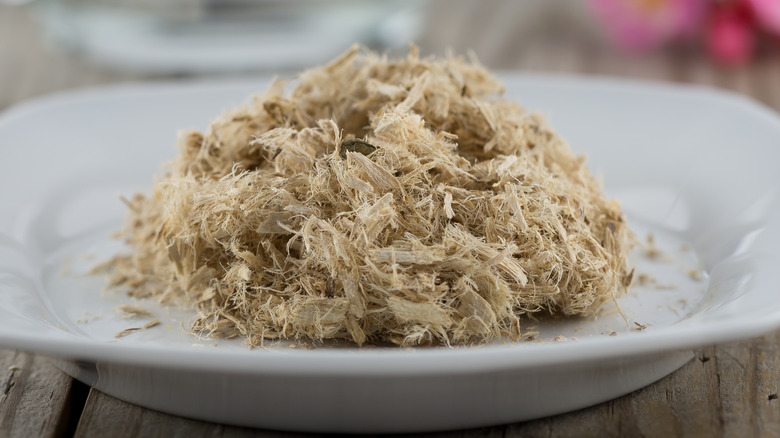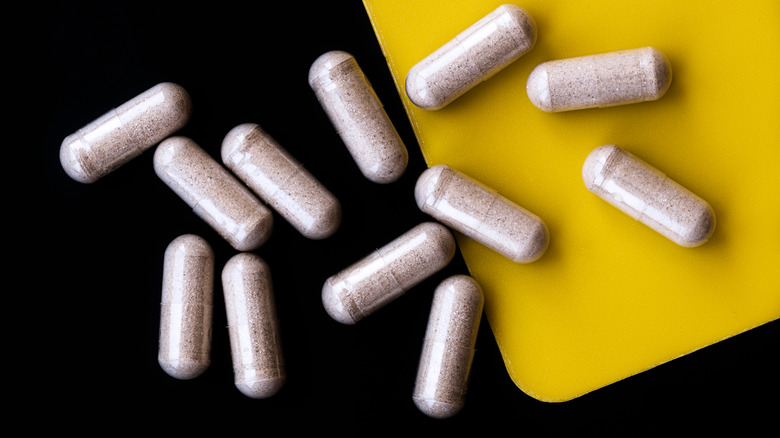What Is Slippery Elm And What Are Its Benefits?
The use of herbal medicine has increased over the past years. According to a 2008 study published in the Journal of General Internal Medicine, 1 in 5 American adults reported using herbal products — Echinacea, ginseng, and Ginkgo biloba being the most commonly consumed. Although not as popular as the rest, slippery elm is also drawing attention. The plant is also known as red elm and Indian elm, amongst other names (via Drugs.com).
According to MedlinePlus, slippery elm is native to North America, and its name is largely due to the slippery inner bark that can be chewed for medicinal benefits. From what is known of its history, Native Americans used the plant to relieve coughing, diarrhea, and gastrointestinal diseases (via this 2014 article published in the journal Intestinal Research). According to the study, slippery elm might also be effective for other conditions, such as inflammatory bowel disease (IBD), due to the plant's antioxidant effects.
Despite the above-mention benefits, solid research about the plant's effectiveness for medicinal purposes is slim. Furthermore, the medical use of slippery elm hasn't been approved by the U.S. Food and Drug Administration (FDA), according to Drugs.com. For this reason, it's best to remain cautious and avoid using the plant as a replacement for any medicine you're currently on. Most importantly, be sure to consult your doctor before use.
Listed below are some possible benefits of slippery elm.
Acid reflux and GERD
Acid reflux occurs when stomach acid backflows into the esophagus causing a burning sensation, according to MedicalNewsToday. Occasional acid reflux can happen to anyone. However when it occurs too often, you might be diagnosed with gastroesophageal reflux disease (GERD), which affects approximately 20% of Americans, says MedicalNewsToday.
People with GERD may benefit from taking slippery elm since its mucilage content can coat the esophagus and help prevent irritation and inflammation symptoms that occur when stomach acid flows back into the esophagus. A 2018 study published in the Journal of Alternative and Complementary Medicine reiterates that slippery elm has been used as an emollient for gastrointestinal and other mucous membranes, especially in Ayurvedic practice, where the plant is a mainstay. Despite its known health benefits, the impact of herbal medicines like slippery elm on the gut microbiota has been understudied, says the study.
Irritable bowel syndrome
Irritable bowel syndrome (IBS) is a common digestive disorder associated with abdominal pain, constipation, and bloating. However, the cause is mostly unknown. Slippery elm's medicinal elements make it a potential alternative treatment for IBS symptoms. A 2010 study published in The Journal of Alternative and Complementary Medicine revealed the effects of a dried powdered form of slippery elm when combined with powdered bilberry fruit, cinnamon quills, and agrimony aerial parts. The results showed an increase in bowel movement frequency and stool consistency. However, the mixture failed to significantly improve symptoms for patients with diarrhea-predominant IBS.
Slippery elm bark is also described as a demulcent — a mucoprotective agent that can help soothe the stomach and intestinal lining and reduce irritation (via Healthline). The source further cites numerous studies supporting the health benefits of slippery elm for people with IBS. However, most of these studies call for more research due to the current evidential inadequacies.
MedicalNewsToday advises people with IBS to consider other treatment options, like tweaking their dietary and lifestyle choices. The source recommends following a low-FODMAP diet, avoiding gluten, and eating more fiber-rich foods.
Sore throat and coughs
According to Healthline, the plant contains a sticky mixture of sugars called mucilage which is difficult for the digestive tract to break down. Mucilage works by coating the throat just like some throat lozenges do. Also, slippery elm can be labeled as an antitussive, making it a potential treatment for other throat or respiratory conditions, including bronchitis or asthma, per Healthline.
According to a 2002 study published in the journal Alimentary Pharmacology and Therapeutics, slippery elm has antioxidant properties. Antioxidants are more commonly found in plants and are needed to inactivate free radicals, says the Cleveland Clinic. According to MedicalNewsToday, different types of teas have high antioxidant properties, which can help soothe a sore throat. Slippery elm might also come in handy when consumed as a tincture, according to another article by MedicalNewsToday.
According to MedlinePlus, it's still unclear exactly how the plant helps people with cough, and there isn't enough evidence to back this claim. If it fails to work, it's best to resort to other sore throat remedies or consult your doctor.
How to use slippery elm
Since there isn't much information about slippery elm's appropriate use, it's always best to follow your doctor's instructions. According to WebMD, only the inner bark of slippery elm is appropriate for medicinal use since it contains essential chemical properties that may increase mucus secretion and helps treat certain conditions. Also, slippery elm comes in various forms, including tea, capsules, tablets, lozenges, and powders, resulting in different application methods (via MedicalNewsToday).
Healthline recommends mixing a tablespoon of slippery elm powdered bark with tea or water for acid reflux. You can take the mixture about 3 times daily, adding sugar or honey if needed. If you prefer taking capsules, Healthline recommends 400- to 500-milligram capsules three times a day. It's always best to consult your doctor about how long to take these capsules. However, as a guide, Healthline recommends stretching the therapy over up to an eight-week period for safe and effective results.
Side effects and precautions
Since much of the evidence backing slippery elm's health benefits is anecdotal and lacking, it's also crucial to understand the side effects. According to WebMD, slippery elm may cause allergic reactions and skin irritations and might be unsafe for pregnant and breastfeeding mothers. Also, it might risky for children and people with underlying health conditions (via MedicalNewsToday). Consult with your doctor before taking slippery elm if you belong to one of these groups.
Combining different formulations of slippery elm may lead to overdosing (via Drugs.com), so its best to best to stick to a specific form as directed by your doctor. Also, if you're currently on medications, slippery elm, being a mucilage, may influence how much medicine the body absorbs, limiting the medicine's effectiveness, says Healthline. Therefore, slippery elm is best taken an hour after any drug, according to Healthline.
Generally speaking, not all herbal remedies are safe to consume despite being natural. Your doctor might only prescribe slippery elm after a proper health assessment. Don't hesitate to report any unexplained symptoms, even if your doctor declares the plant safe.






